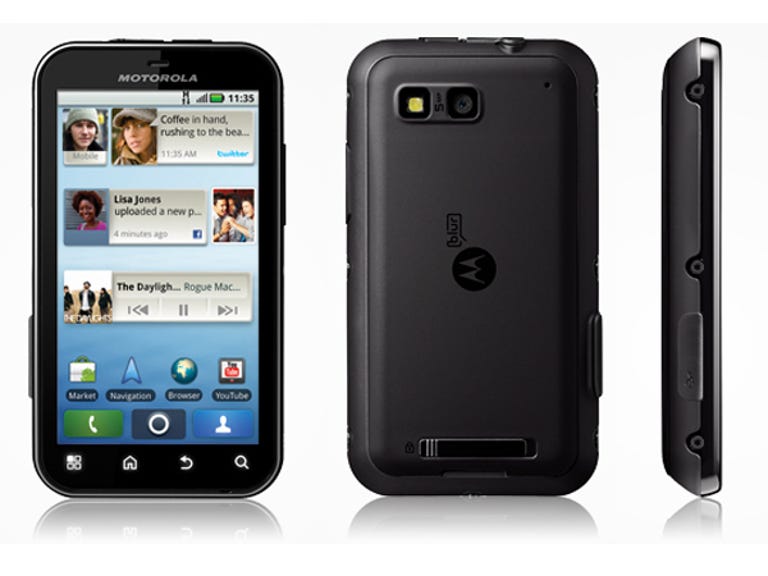 Why You Can Trust CNET
Why You Can Trust CNET Motorola Defy review: Motorola Defy
If you've smashed an iPhone or dropped a Droid in the dunny, then you're probably in the market for a Defy, an Android smartphone with some great features and a protective rugged chassis.
Construction workers and klutzes have reason to celebrate. After demolishing numerous smartphones due to improper handling, there is finally a touchscreen handset that is not only dust and shock-proof, but water-resistant as well.
The Good
The Bad
The Bottom Line
Design
If you've researched rugged phones before, you'll know they are universally ugly devices. The Sonim series of "indestructible" phones may be able to withstand a bullet, but its Transformers-like chassis is bulky and far from the best fashion accessory for a night out in a fancy restaurant. The Moto Defy bucks this trend, and though its matte plastic body falls short of being absolutely drool-worthy, it is a cool-looking handset nonetheless.
Around the edges of the Defy you'll find six screws, and the battery cover is locked down with a sliding latch. This, apparently, provides enough protection to withstand being submerged in up to one-metre of water, and though you'll probably still want to keep it away from water where possible, it is sufficient to survive rain and, god forbid, being dropped in the dunny. We completely submerged the phone in a glass of water for several minutes while shooting the video review (above) and found the phone to be completely functional afterwards. Interestingly, you can't use the touchscreen underwater. We found that the touchscreen actually responds to water, so there's no chance of taking this phone scuba-diving for some impromptu underwater photography.
Protecting it from the keys in your pocket, the 3.7-inch capacitive touchscreen features Gorilla Glass. The touchscreen is reasonably responsive, though like the Milestone 2, we have noticed that interacting with the Defy can seem a bit sticky at times. The phone will respond to gestures promptly, but animations, like scrolling through the list of installed apps, can appear a bit jerky. Motorola has included a Swype keyboard in the Defy, and while we love this addition, it is yet another example of where the response time of the phone can drop to an irritating level.
Features
Beneath the rugged good looks of the Defy beats the heart of a fairly average Android smartphone— in terms of software. The Defy runs on Android 2.1 with Motorola's MotoBlur version 1.5. At the risk of sounding like a broken record, we don't like MotoBlur very much. It takes the enormity of the social network experience and distills it down into a handful of widgets and an app that pools all of this information into one not-particularly streamlined location. We spent about a day with MotoBlur before we removed the widgets from the homescreen and installed TweetDeck instead.
But there are other parts of the standard smartphone experience that Motorola does very well. The music player in the Defy is probably the best music application we've used all year. It does the basics well; it plays music loudly, displays album art, has multiple search filters for organising music; but it also adds a couple of really excellent web services. There's TuneWiki, an app that streams album art and the lyrics of the song you are listening to so that you can sing along. It can also show other TuneWiki users on a Google Map so you can discover new music through what they are listening to. Shoutcast is also installed and lets you tap into the vast, seemingly endless world of internet radio. But our favourite part of the player is the YouTube integration. If you feel your music needs a visual component you can launch a YouTube video search of the song and artist you are listening to from the menu and play the clip without leaving the music player.
Cinema lovers will also make good use of the baked-in DLNA media sharing software, identical to the Media Share tools we found on the higher-priced Milestone 2. With Media Share you can stream videos, photos and music in both directions, plus you can transfer files to and from your phone. This is very handy when you are visiting that friend who happens to have an amazing library of media.
We also found the 5-megapixel camera to be better than your average smartphone shooter. It's paired with a dual-LED photolight and features all of the customisable settings users probably expect in a camera of this calibre, but its the pictures that have really won us over. After taking 50 or more photos, we were pleased to see a majority of those were in focus, and the colour of the scenes to be accurately recreated. With the LED photolight doing well not to overpower the photos, the camera does a fine job even in low-light situations.

The 5-megapixel camera is good enough to capture this sleepy pup's gross, goopy eyes.
(Credit: CBSi)
Performance
As we noted early, the performance is consistent, but the Defy could use a bump in processing power to run the system MotoBlur infused Android platform without jagged, jerky animation lag. This isn't to say we've struggled to use this phone, in fact we've had a great time using it as our day-to-day handset, but it certainly lacks the polish of this year's best touchscreen smartphones.
Call quality during our review has been exceptionally good. We tested the Defy on Telstra's Next G network and found the people we spoke to sounded as clear and natural as they'd be if they were standing in front of us. Data speeds were also good and the phone was prompt in deferring to WiFi when we can within the range of a known network. For rural readers, Telstra has also informed us that the Defy is the latest addition to its Blue Tick range of phones, indicating superior coverage for customers who might otherwise struggle to make a call.
Overall
There's plenty to like about the Moto Defy: it offers a good smartphone experience with Android and protects itself from the bumps, knocks and splashes of everyday life with its rugged casing. What's really won us over is the extra attention paid to the phone's multimedia, both in capturing and in playback. The camera is well-made, the music player is first-class and the DLNA media sharing feature is a welcomed bonus. We wish Motorola had used a more powerful processor and more RAM to iron out some of the issues we've experienced with lag, but if you can look past this these niggling frustrations you'll discover a very capable phone in the Defy.


